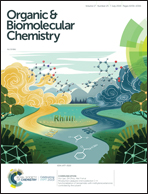Discovery, biological evaluation, structure–activity relationships and mechanism of action of pyrazolo[3,4-b]pyridin-6-one derivatives as a new class of anticancer agents†
Abstract
We have recently reported computational models for prediction of cell-based anticancer activity using machine learning methods. Herein, we have developed an integrated strategy to discover new anticancer agents using a cascade of the established screening models. Application of this strategy identified 17 compounds with antitumor activity. Among these compounds, h2 (containing a pyrazolo[3,4-b]pyridin-6-one scaffold) exhibited anticancer activity against six tumor cell lines, including MDA-MB-231, HeLa, MCF-7, HepG2, CNE2 and HCT116, with IC50 values of 13.37, 13.04, 15.45, 7.05, 9.30 and 8.93 μM. Subsequently, a total of 61 h2 analogues were obtained by similarity searching and tested for their anticancer activities. I2 was identified as a novel anticancer agent having activity against MDA-MB-231, HeLa, MCF-7, HepG2, CNE2 and HCT116 tumor cell lines with IC50 values of 3.30, 5.04, 5.08, 3.71, 2.99 and 5.72 μM. I2 also showed potent cytotoxicity against adriamycin-resistant human breast and hepatocarcinoma cells. Further investigation revealed that I2 inhibited the microtubule polymerization by binding to the colchicine site, resulting in inhibition of cell migration, cell cycle arrest in the G2/M phase and apoptosis of cancer cells. Finally, molecular docking and molecular dynamics provided insights into the binding interactions of I2 with tubulin. This study identified I2 as a novel starting point for further development of anticancer agents that target tubulin.
![Graphical abstract: Discovery, biological evaluation, structure–activity relationships and mechanism of action of pyrazolo[3,4-b]pyridin-6-one derivatives as a new class of anticancer agents](/en/Image/Get?imageInfo.ImageType=GA&imageInfo.ImageIdentifier.ManuscriptID=C9OB00616H&imageInfo.ImageIdentifier.Year=2019)
- This article is part of the themed collection: Chemical Biology in OBC


 Please wait while we load your content...
Please wait while we load your content...